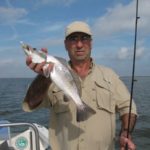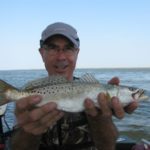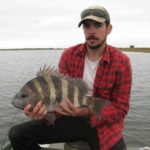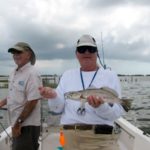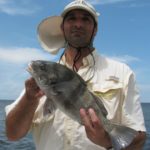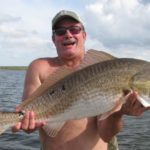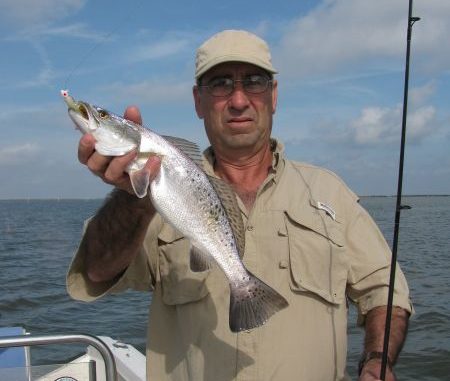
Anglers will flock to the Grand Isle surf this month in hopes of wading into some trout, but launch and Myrtle Grove to fish your way to the island — and ensure you have plenty of fish for da paaaw-ty.
“Good luck with DAT!” Artie laughed as Spencer and Doc unveiled their fishing plans at the “Pre-Memorial Day Paaaw-ty Luncheon” (which itself turned into a pretty nice paaaw-ty).
“Tell you what,” Artie continued while putting down his oyster po-boy and looking around with a chuckle. “We’re going with Plan B — OK?
“Plan A, actually for us, since it’s been our plan from the get-go.”
Many heads suddenly turned toward Artie.
“Looks like we’ll be feeding about 30 of us for the Memorial Day paaaw-ty, right?” he asked.
Many heads now nodded agreement.
“Well, ain’t no way we’re gonna pull dat off relying on you guys to provide the fish — especially by surf-fishing at Grand Isle,” Artie said, pointing at Doc and Spence while laughing and rolling his eyes). “This ain’t a job for dilettante fishermen! Ya follow what I’m saying?”
Please don’t get Artie wrong: Surf fishing Grand isle can be among the most-enjoyable and productive fishing ventures in South Louisiana. And we’re major fans — beating the heat by wading in the waaaw-da. Watching the specks swirling on the surface right in front of you as they grab your bait. Whooping as they fling themselves into the air. Watching that stringer fill.
What a ball!
But Artie had a point, as he kindly (and rather loudly) explained.
“It just ain’t the most predictable type of fishing. Shoot man, just a little wind from the southeast — the most common this time a year — will muddy up dat waaaw-da to where you’ll be hard-pressed to catch a hardhead, much less enough specks to feed our usual Memorial Day crowd!” he said, building up steam. “And even clean waaaw-da ain’t no guarantee the specks be turned on.’
Uh-uh, no way. Y’all get the crabs — pretty much a sure thing at Grand Isle — we’ll supply the fish!”
Much of the gang was now nodding.
“So we’re taking the shortcut to Doc’s Grand Isle camp,” Artie yelled, while the rest of the heads turned. “And we’ll stop along the way for the groceries.
“Don’t worry. We should be getting there Saaah-dy evening with a load of fish. We plan on having enough for both frying and grilling. Got it?”
By “groceries” Artie meant the fish we planned to catch in the marshland, islands and bays between Myrtle Grove and Grand Isle — the southeast “Barataria estuary,” as some call it.
And we needed both: plenty school specks for frying and a nice little mess of puppy drum, sheepshead and reds for grilling.
This shortcut to Grand Isle meant launching at Myrtle Grove in Plaquemines Parish and heading straight south down Wilkinson Canal and across the middle of Barataria Bay to Doc’s Grand Isle camp.
It’s not exactly “short” — more than 20 miles by boat — but it’s almost a straight shot and gives a veritable plethora of fishing options along the way.
You can hit the marsh drains along Wilkinson canal, deeper holes and channels in the passes leading into Bays Round and Batiste and Lake Five, or the current lines and islands in Bays Batiste and Barataria.
In brief, there are plenty of options.
That’s the beauty of our coastal fishing: the options.
And that’s the crazy thing about many of us coastal fishermen — how often we ignore these options. We get hung up on targeting specks in one area using one tactic, while overlooking all the other delicious and tough-fighting fish that bless our coast.
None of that for us.
As mentioned, we’d certainly look for specks. But not with tunnel vision.
Nobody would call us politically correct. But when it comes to our fishing, we certainly celebrate diversity.
Nobody’s gonna find “Coexist” bumper stickers on our trucks and SUVs. But many diverse “creeds” and “colors” certainly “coexist” in the ice in our box, the coals in our grill and the grease in our fryer and later on the buffet table at Doc’s.
Not 10 minutes after launching, we hung a right into Lake Five, and gently anchored near a point with a little current moving around it.
A boat was idling past us, and the three occupants were giving that arm-extended, frowning and nodding gesture. You know, the one that asks. “Where da fish at, bro?”
“Just got here,” Artie yelled back with shrug.
In fact, tidal movement was small this day. So we didn’t just bumble onto this spot. Instead, we found it by searching for what we always search for under these conditions: wind-driven water.
You see, that southeast wind that was probably muddying the Grand Isle surf was benefiting us here by pushing water around an oyster shell-lined point. So it created the same effects as a rapidly dropping tide, which is what we always crave for our type of inshore fishing.
But on those days when the tidal charts aren’t cooperating we resort to this.
Artie’s cork smacked in the middle of the current and was quickly swept along.
“Dagnabbit!” he snarled. “My line’s kinda stretched and twisted from dat jackfish I fought for 20 minutes last week. Missed my spot.
“I was actually aiming over there.”
He pointed with his rod to almost exactly where Pelayo’s cork was headed.
Pelayo’s cork hit the calm pocket near the oyster shell-lined bank, where the semi-clear water lapped over the green spartina grass.
Two feet under his cork, Pelayo had rigged up an extremely exotic and newfangled rig: A green (chartreuse, technically) sparkle beetle sweetened with half a shrimp — MAAAW-KET bait.
And the cork was gently dancing in a spot that had redfish written all over it.
Pelayo popped it once — twice — and then it plunged.
WHAM!
He struck hard, with his rod high overhead. Almost instantly his vintage Mitchell 300 started singing its sweet, sweet music.
“KNEW IT!” Pelayo roared. “Look-it him GO! And listen to my drag!
“Ain’t nutin’ sounds sweeter than DAT!”
He held the pole high overhead — exactly like he lifts a sound-system speaker to get better volume for a disco tune at one of Doc’s paaawties.
Pelayo ended up netting his own 7-pound red because Artie and I were too busy with our own fish — another red and a nice puppy drum hooked within 10 feet of each other.
The fish were staging in that little calm area — an ambush point. This way they conserved their energy, waiting in ambush while the current did all the work, bringing the food to them.
In the case of reds and drum, this food — as we always find when opening the stomachs while filleting — consist primarily of little crabs.
We boxed three more reds another puppy drum and two bruiser sheepshead by anchoring near similar points featuring current or wind-driven water and cork-fishing with shrimp-tipped beetles and cocahoes.
More specifically, we zeroed in on areas with 2-plus-foot depths and oyster-studded bottoms.
The anchoring meant we worked the area over good.
Under these conditions, fish aren’t crazy ravenous. So it sometimes takes a bit to entice them. That’s where cork-fishing helps — it keeps the bait in the strike zone longer.
And many of these strikes were also provoked by using shrimp (which all fish love — yes, I know, including hardheads, of which we flipped off about half a dozen during the morning.)
How often we’ve seen a shoreline worked with trolling motor and lures to no avail, and then pulled up, anchored, bait-fished and hauled out a few reds and drum.
Happens often.
Then we headed to the Wilkinson Canal to Barataria Bay, where Artie hauled back on the gas so we could slow down and survey the area for Da birds.
“Forget da birds!” Pelayo laughed. “Now, they got it easy around here — shrimp season’s open. So they’re following the shrimp boats.
“We’ll have to find the specks without their help. Instead, let’s look for feeding slicks.”
Alas, the stiff wind seemed to nix that, too. So we slowly pounded our way to an island north of Four Bayou Pass, whose angle provided a nice lee area.
And sure enough!
“Looky dere!” Pelayo pointed.
But I couldn’t see a thing. His polarized glasses, however, allowed him to spot the telltale slick.
I took his word for it.
So we cut off the engine, drifted in and three corks quickly sailed slick-ward.
Two disappeared behind a swell and never came back.
“We’re ON ’EM!” Artie yelled, as a school speck hit the surface in the trademark gill-rattling frenzy while Pelayo’s swirled on the surface.
Soon three schoolies were thrashing on the surface — as a wild chorus of whoops erupted from the boat.
After almost 40 years of this stuff, three little school specks still totally unhinge us. We were beaming as we swung our three trout aboard. No monsters: chunky school trout in the 13- to 15-inch range.
Two similar spots and 27 specks later Pelayo texted Doc.
“The fish feast is ON! So how da crab’s running?”
